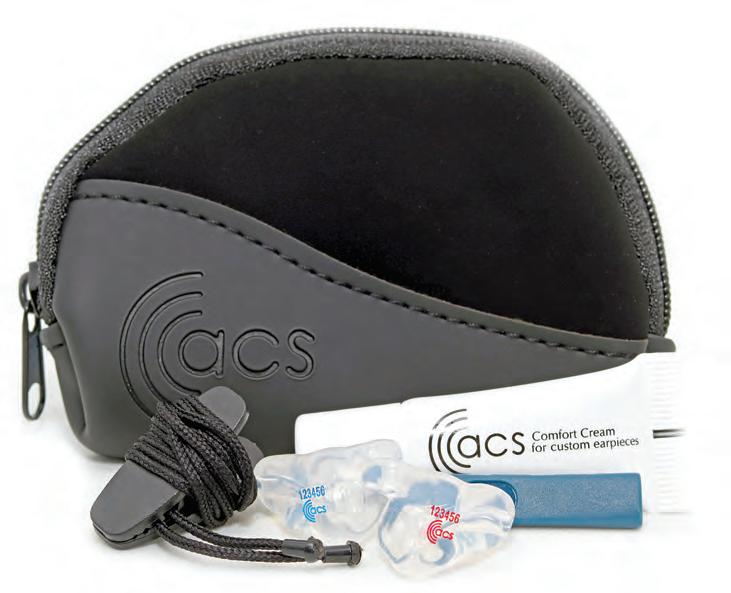
5 minute read
Protecting hearing in noisy environments
from STW Sep 2020
by Prime Group
ALL-ROUND HEARING PROTECTION NEEDS TO REFLECT THE DEMANDS OF EACH JOB. CUSTOM FIT EAR PLUGS WITH INTERCHANGEABLE FILTERS ARE PART OF THE MINING EQUATION.
Alawyer by trade, Terry van Dijk has acquired a hearing protection company that supplies solutions to the industrial sector, but also to Sydney Opera musicians, Victorian Police and people in the motorsports industry.
The reach of the company, Pacific Ears, has grown since it came under van Dijk’s leadership in early 2018.
“We’re getting ourselves known now, by increasing our presence and brand awareness, and we have answered to the concerns of hearing damage across the board,” the owner/ director tells Safe to Work.
The secret lies in the composition of Pacific Ears’ hearing protectors. They are made of soft silicone custom fitted mould with replaceable filters according to the need or application.
A class two or three filter may be sufficient for Sydney Opera musicians, but not for miners who regularly work in louder environments.
“There is a 24-hour activity going around heavy machinery,” van Dijk says.
“The exposure to that much noise will lead to hearing damage if not
The Pro series custom ear plugs are made from soft, medical grade, hypoallergenic silicone.
protected early and properly.”
According to van Dijk, employers are trying to do right by their valued staff, but some simply don’t have the sufficient knowledge to be making the right decisions.
This starts with them providing a higher attenuation, or sound reduction, than required.
“Providing a class five product where a class three would suffice can lead to isolation and non-compliance,” van Dijk explains.
“On the other hand, class five product that reduces mostly low frequencies might be insufficient in a high-frequency environment.”
In response to this issue, years have been invested into developing the housing and vented filter design that underpins the current hearing protectors.
Van Dijk even calls the development a “breakthrough in high-noise filtering.”
Pacific Ears’ Pro series custom ear plugs, for example, reduce sound to safe levels without causing muffling or occlusion.
As a result, the wearer can hear safely and clearly while being protected from dangerous sound levels.
They are also made from a soft, medical grade, hypoallergenic silicone to ensure a safe and comfortable fit, and keep shape after years even with perspiration and rain. They can be worn for a long period of time, even throughout an entire shift.
This allows people to communicate with each other, hear warning signals and back up alarms and still perform their job in comfort.
“Our goal is to not only make the best possible hearing protection through a filtered system, but also to improve comfort, which will eventually lead to better compliance and therefore safety again,” van Dijk says.
“And we received lots of positive feedback on our products; the user
acceptance is very high.”
Beyond the open space, the Pro series ear plugs are suitable for use in confined areas. They are also a suitable double layer of protection as there is no interference with safety glasses, hats and other forms of personal protective equipment (PPE).
Custom fit hearing protection has gained in popularity throughout Europe and the United States.
Many people in those regions have left the use of earmuffs that are still common in Australia and New Zealand’s heavy industry behind.
As technology has advanced over the past decade, a shift is also taking place among employers that isn’t exclusive to larger companies, van Dijk explains.
They are searching for information about sustainable and durable hearing protection.
“They realised that foam plugs and earmuffs were not sufficient, and that people who wore earmuffs tended not to wear them all the time for a variety of reasons, among which are lack of comfort and feeling of isolation, making them prone to hearing damage,” he continues.
“There are reports coming out stating that employers are paying $500 per staff member per year for hearing protection, foam plugs and earmuffs, and yet the damage numbers are unnecessarily this high.”
According to van Dijk, noise induced hearing loss is the most commonly reported occupational disease, particularly in mining. Yet it is also the most underestimated health concern on the work floor.
Anyone who is exposed to noise is potentially at risk, and the higher the noise level and the longer someone is exposed to it, the greater the risk of suffering injuries from noise, van Dijk says.
“In manufacturing and mining, 40 per cent of employees experience
significant noise levels for more than half of their working time,” he says.
“By age 60, 75 per cent of miners suffer from noise induced hearing loss. Many miners will recognise symptoms such as difficulty hearing warning signals and hearing others properly; background noises that are louder than those closer to them; ringing or buzzing of the ears; headaches; fatigue; stress; and dull or muffled hearing after leaving
The Pro Series are available in a pouch that includes a comfort cream. a noisy area. These all have to do with an overexposure to noise.”
Sadly, noise pollution can adversely impact a person’s mental health. This could start with distraction and the inability to concentrate, before progressing into irritation, poor job performance and frayed temper.
Numerous studies have also linked noise pollution to increased anxiety, depression, high blood pressure, heart disease and strokes, van Dijk says.
“In hearing protection, prevention is the only option. Hearing Loss is irreversible. We rather prevent than try to cure the incurable,” he says.
Beyond the job site, Pacific Ears has developed sleeping ear plugs to improve miners’ quality of rest.
“We have developed the softest and longest lasting sleeping plugs to get those extra hours in,” van Dijk says.
“A common misconception is that custom hearing protection is expensive, but if you calculate it per pair per user, it is the most economical and more environmentally friendly solution.”











